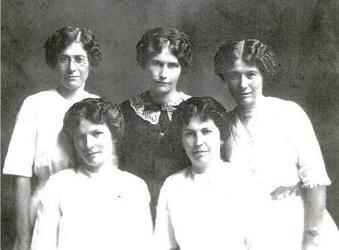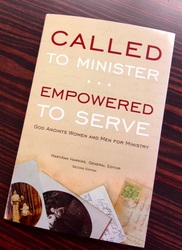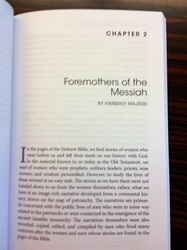|
|
 As an associate professor of bible, I split my time between seminary and strip club because it is my fierce conviction that as the text impacts our lives, we should live accordingly. That is to say, I take seriously Jesus’ charge to be light and salt, I am compelled by his model of shared life and supper with outcasts; I am transfixed by the stories of whores who are also heroines in the plan of God. If you look close enough, you start to discern certain patterns hidden up under the sacred text, all those stories concerning men, handed down by men, interpreted by men across the ages. If you press in, like the woman with the issue of blood and bend over to see what Jesus is doing in the dust, like the woman caught in adultery, you will begin to see a counter-narrative emerge; hope scribbled right into these manuscripts, texts read from the bottom up. When you catch it, you will realize with Hagaar that God sees you and you will laugh out loud like Sarah at the hope of a baby in her barren womb. God has always been on our side. So much like the strippers who are my friends, we tend to read the women of Scripture from the top down and thereby miss the wonder of God’s work before us. It is no accident that all the women named in the genealogy of Jesus are so called scandalous. Like so many women who we read about in the canon, these women were oppressed by a system that left them few choices save to trade their bodies to survive. Tamar disguises herself as a prostitute to lure her father in law to her bed so that she might have a child; Rahab, the harlot, welcomes the Hebrew spies and deceives her own king. At the impetus of her mother in law, Ruth dares to sneak to the threshing floor amidst a gang of drunken men to sleep next to Boaz so that he might take her for a wife; Bathsheba answers the king’s summons and becomes his concubine and the mother of his child. Mary is a pregnant, unwed teen who births forth the son of God. I often wonder if we knew deep the stories of women who went before us, would we be fortified. If we’d heard the stories scraped from the pages of the text, if they’d been relayed to us from the bottom up, from the point of view of woman, slave, victim of sexual abuse, warrior, sage, patrona, would we have received them differently, would we have been encouraged, would we have felt less alone, would we have a sense of our own worth and purpose in God’s plan? It doesn’t take long before you begin connecting the dots between the women of Scripture and sex workers, soccer moms and female seminarians, you begin to find much and more we have in common as women. These commonalities stretch across the ages, reach across religious tradition and geography and socio economic standing. Some of these commonalities, unfortunately, render us paralyzed, unaware of our own divine, feminine power. We are, all of us, afraid. Whether you take your clothes off for money or are scrambling to pack the perfect snack for the team or are working on the final draft of a manuscript for the last two years; we are convinced we are not enough. Women who lead conferences, convene boards, sell their bodies for a living are terrified that someone will find out what we believe is true, we are worthless and wayward, overweight and over obsessed, too thin or too loud, not educated enough, not experienced enough, not credible enough, not smart enough, not beautiful enough, not …enough. Most of us, it seems are starved and searching for stories of hope, stories of survival, stories of women who made it through the struggle, who found a way through the pain, to see and know God as manifest in feminine form, to be able to find ourselves in the miracles of Jesus and borne up on Spirit wings. To this I say, receive the Good News of Christ who rescues, redeems, restores; the Lord your God is on your side. Travel with Kimberly to Greece/Turkey to study women of the New Testament up close and personal May 2014. For more information click here.
1 Comment
 I was so honored to contribute to the anthology, "Called to Minister, Empowered to Serve" along with other female clergy and scholars whom I admire greatly. This book offers a biblical, historical, theological and ethical rationale for women in ministry in the voice of, from the perspective of and in the Spirit of women. Below you can read an excerpt from my chapter on Women in the Old Testament. "Called to Minister, Empowered to Serve" is now available in Kindle Edition at amazon.com In the pages of the Hebrew Bible we find beautiful imagery and noble typography, contours of women who have gone before us and left their mark. In the material known to us today as the Old Testament, we read of women who were prophets, military leaders, priests, wise women and wisdom personified. However, to study the lives of these women is no easy task. The reality is, the stories, as we have them are not handed down to us from the voices of the women themselves, rather what we have is an image rich narrative developed from a covenantal history, drawn upon the map of patriarchy. The narratives then, are primarily concerned with the public lives of men who are or are in some way related to the patriarchs and are connected to the emergence of the monarchy. It must also be stated that the narratives are also recorded, copied, edited and compiled by men who live many centuries after those women and men whose stories they are trying to convey. We must understand at the outset that the material we have existed first as oral tradition and communities were formed around story, many of these stories endured across the generations to be recorded during the compilation of the codices which are now considered canonical by persons of Jewish and Christian faith. To do these women any justice we must unearth information about their world, status, society and gender roles in ancient Israel. We are helped then to also consider archaeology and anthropological studies in concert with the Scriptures to gain a better picture of life in ancient Israel for women. In the Hebrew Bible, we find the stories of a people and a society who traverse the land of the Ancient Near East for more than 1,200 years (Murphy, Cullen: 1993). Of the 1,426 persons named within the narrative of the Old Testament, 111 of these named persons are women. While this seems like a small number, the witness of the lives of these women is powerful and their presence in this male dominated text reveals a prominence held by certain women. Though a casual reading of the Old Testament might leave us with the impression that women were confined to the domain of the home and their sole contribution was procreation, a closer look demonstrates another dynamic altogether. Mayer Gruber points out that women served as judges (Judges 4.4-5), officiated funerals as clergy (Jer. 9.16-19; 2 Chron. 35.25), slaughtered animals in priestly and domestic rites, served as prophetesses and sages (2 Samuel 14; 20.16-22), both nursed children and read Scripture in public settings (Gruber, Mayer: 1999). Gruber has also rightly demonstrated that within the Hebrew Scriptures we have accounts of women as priestesses (Exodus 38.8; 1 Sam. 2.22), poets (Exodus 15.21; Judges 5.1-31; Proverbs 31.1-9), musicians (Ps. 68.26), “queens, midwives; wet-nurses; babysitters; business persons; scribes; cooks; bakers; producers of cosmetics (I Sam. 8.13 ) as well as innkeepers and prostitutes (Josh.2).” While the scope of this study will not allow us to consider the 111 named women of the Hebrew Bible, we will take a representative group and trace their lives, their communal impact and their covenantal significance. We do this in effort to illuminate the reality that though the narrative of Hebrew Bible is primarily concerned with the lives of the patriarchs, there exists also a counter narrative that demonstrates the activity of God present and powerful in the lives of many women which reverberates through the nation of Israel for the good of the world. The group we will consider here is the women of the genealogy of Jesus offered in Matthew’s Gospel as each of these women emerge from the story of ancient Israel and the tradition of their contributions endure into the New Testament Canon and beyond. The narratives of these women, Tamar, Rahab, Ruth, and Bathsheba offer us traditions of women who were significant in the life of ancient Israel if also representatives of life in a given place and time who simultaneously rise from the narrative to demonstrate women as agents of God’s covenantal and universal work. Want to Read More...get your copy today!  Center Rev. Ada Cooper, Hermitage Church of God, Hermitage, TN In response to Patheos.com “Why I am a…” in 200 words or less: I am Church of God, Anderson, IN because I was raised up in love. I have been reared in the tradition that also loved and fostered my parents and grandparents. I was born into a local church where a founding pastor of the 1930’s had been a woman, raised up under a sense of welcome and inclusion, taught the distinctions of our Wesleyan-Holiness heritage. I was reared in a church where I was invited to sing a special at six years old, where I watched women kneel and wash the feet of other women, spread the feast for a pie social and gather for Tuesday morning prayer. As an adult I pursued ordination in this tradition and have attained graduate degrees at our School of Theology where I now also teach and I am committed to the fierce, radical passion for justice and evangelism that animated the earliest days of our Movement. I am the Spirit daughter of Lena Schoffner, pioneer Church of God preacher who demanded the rope separating races be torn down, I am an heir to the Movement who would welcome Every One to the table of love.  It's not too late! If you are a clergy woman or a woman preparing for ministry, join us for Rise Up, the tenth annual Wesleyan Holiness Clergy Woman Conference. This was the single most encouraging event of my formation as a woman called to ministry and academy. Here you will worship with other women on a similar path, you will be challenged and equipped for ministerial life. The conference is conceived around workshops that are both academic and practical along with up close and personal time for networking with other women in your tradition and field. Break out sessions include: Narrative Preaching, Balance in Ministry, Responding to the LBGT community, Interfaith Dialogue, Prostitution and Sex Trafficking, Exploring Publishing, and a new Social Justice track added this year. If you need to be refreshed, inspired, encouraged, empowered, if you need to laugh and cry and worship with other women in your vocation; this is the place for you!! Join us in Estes Park next week!! It's Here!! The latest edition of Called to Minister, Empowered to Serve is hot of the printing press and will be available at The Wesleyan Holiness Women Clergy Conference, April 11-14, at warnerpress.org, anderson.edu/sot and Amazon.com. Edited by Dr. Mary Ann Hawkins this book is a collaboration of love by women clergy and scholars in the the Church of God Movement, please find the chapter penned by yours truly below!!
 Fracctico Panis, Catacombs of Priscilla Below freezing outside, the ground blanketed with new fallen snow, they come in from out of the cold, wet galoshes and heavy down coats dropped by the door. It is Friday morning, mid-winter in Indiana and they bring butter cake, cranberry muffins and clementines; the flames dance in the fireplace, the coffee pot hisses fragrant hot steam and we come together and thaw. My home, visited by wisdom personified: women, leaders, ministers, seekers, sisters, daughters, mothers, mentors. We sip our coffee and share our lives. There are new babies to brag on, photos of the living dolls to pass around and fawn over, there are stories to tell, ground covered on the journey from last time until this. There are miracles to claim, praise to be given for those angels keeping watch, there are burdens to share, there is pain to confess. We laugh and eat and testify and my mind drifts to a place like this before us. Far below the centuries of civilizations long come and gone on the Aventine Hill in Rome there lies a chamber beneath the rubble, inside the ancient Catacombs of Priscilla. Beautiful reliefs are painted on the wall throughout, images of women, pillars of the early church, Mary the Virgin, Theodora, Thecla and the Magdalene, their stories of surrender and grace all but lost to us now. Except for this funerary chamber, this cavern in the ground, this shrine for women valiant in the faith, this safe space where it seems they gathered for centuries to worship in Jesus’ name. It is no secret to any student of Scripture that there was a time in the early days of the community of the baptized when women taught and encouraged, led and gathered the believers into their homes, those safe abodes and first sanctuaries of early Jesus followers. Even in the turmoil of the first centuries, in the midst of the struggle for identity and the battle to sustain what the Spirit had birthed, we find these sacred places hewn in the stones of the earth where holy women gathered to share the Lord’s meal to kneel and pray. After the sanctuaries of the home had been abandoned, given way to cathedrals, long after women had been silenced in the church, still they gathered and we know some came here, to Priscilla’s Catacombs to this chamber because they believed it to be the resting place of St. Prisca, early church leader and ministry partner of Paul. An ancient fresco is stained into the stone commemorating seven women gathered together to share the Feast of the Lord. I sample the butter cake and I think about them and us, all women, all called, all struggling to stand and sustain what the Spirit has birthed. I think about how much we all need each other, how grateful I am to have been visited today by my wise companions, those gathered now and those who gathered before us. I raise my hands and I give thanks for women wise and sacred space.  A month long hiatus from my mini marathon training finds me lying on the couch, crackers in hand, wistfully watching the pristine, chiseled athletes of the 2012 Olympics. I wonder as I watch them, twirl on the uneven bars and pummel the ball across the net, what drove them to wake up at 4 a.m. and swim morning laps in a neighborhood pool while the rest of us slept in our beds. Today, haunted by images of disciplined Olympians and the half marathon training schedule that lingers on my laptop, not opened in five weeks, I rolled my soft body back into my running shoes. It wasn’t pretty, the heat unbearable, but at least, I’m moving again and sometimes, glorious things can come of failed plans and just being where you are. This calls to mind, the life of the Apostle Paul. Sometime near 49-51 A.D., Paul made an appearance at the Jerusalem Council and gave an account for the healing and Holy Spirit work that had been taking place in the Empire among those who were not of the House of Israel. This will be Paul’s first official report to the Good Brethren in Jerusalem, where, he is called on the proverbial carpet regarding the questionable doctrine he had been teaching. According to Paul, for freedom Christ had set us free, the Law of the Fathers was no longer needed since in Christ Jesus the Law is love alone. After this encounter, Paul receives the blessing of James and sets out on his next missionary journey believing the matter of Gentiles baptized into Christ without the sign of circumcision is behind him. According to Acts, Paul and Silas travel first to Bithynia because the Spirit had not permitted them to preach in the Asia province at that time, but when they arrive near the coast, they are stopped this time by the Spirit of Jesus from entering the city. Paul, it seems, has every reason to be confounded by the failure of his plans. First, a senseless detour to Jerusalem and now heaven itself seems to be creating obstacles, frustrating his plans! That night, after feasting on salt fish and throwing back a few pints of ale, Paul falls asleep to the sound of the waves crashing into the beach at Troas. Belly full, mind buzzing, confidence brooding, Paul dreams of a man in Greece calling out to him, begging him for help; when the sun rises, Paul understands his mission. When Paul arrives in Greece, he first visits the prominent Roman city of Philippi. The city of Philippi was the settlement colony for all those soldiers who had fought with Antony and Octavian against Brutus and Cassius, the conspirators who had stabbed and killed Gaius Julius Caesar. In Paul’s time, a wealthy port city, Philippi had no synagogues for Paul to visit as was his custom; instead, he meets a woman named Lydia and the women of her household who are down by the river when he arrives. Acts tells us that Lydia and her entire household are baptized, thus these women are the beginning of the house church in Philippi and the first converts in Europe. The church of Philippi will grow and flourish across the centuries, according to Polycarp, it is the strongest of all churches planted by Paul well into the 2nd century. Paul refers to this church as his “joy and crown” and will write to encourage female leaders to work out their differences for the good of the community (Philippians 4). The women and men of Philippi will underwrite much of Paul’s missionary work so that he is able to plant churches throughout the Roman Empire. Philippi was not where Paul intended to venture, Lydia was not whom he intended to encounter, but as it turned out, the time, the place, the partnership were all Spirit born and God breathed for the purpose of preaching Christ. Just like Paul, I am sure every Olympian has faced some setbacks and even some dead ends that turned out to be new dreams. What are those places in your own life that you believe are dead ends that might turn out to be new beginnings? What are your frustrated plans that might be opportunities for divine appointment? |
Subscribe Today for Free GiftBLOG
Archives
June 2019
Categories
All
|



 RSS Feed
RSS Feed